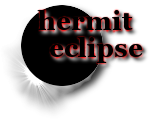1 Jan, 1992 BC
max: 11:31 UT
Penumbral Lunar Eclipse
(penum. mag. 0.85; Saros -17)
|
At maximum eclipse, 85% of the Moon's disc was partially shaded by the Earth, which caused a slight shadow gradient across its disc; this subtle effect may have been visible to careful observers. No part of the Moon was in complete shadow. The eclipse lasted 3 hours and 54 minutes overall.
|
|
12 Jan, 1974 BC
max: 20:04 UT
Penumbral Lunar Eclipse
(penum. mag. 0.82; Saros -17)
|
This subtle penumbral eclipse may have been visible to a skilled observer at maximum eclipse. 82% of the Moon's disc was partially shaded by the Earth (none of it was in total shadow), which caused a gentle shadow gradient across its disc at maximum; the eclipse as a whole lasted 3 hours and 50 minutes.
|
|
23 Jan, 1956 BC
max: 04:30 UT
Penumbral Lunar Eclipse
(penum. mag. 0.78; Saros -17)
|
This subtle penumbral eclipse may have been visible to a skilled observer at maximum eclipse. 78% of the Moon's disc was partially shaded by the Earth (none of it was in total shadow), which caused a gentle shadow gradient across its disc at maximum; the eclipse as a whole lasted 3 hours and 44 minutes.
|
|
3 Feb, 1938 BC
max: 12:47 UT
Penumbral Lunar Eclipse
(penum. mag. 0.73; Saros -17)
|
This subtle penumbral eclipse may have been visible to a skilled observer at maximum eclipse. 73% of the Moon's disc was partially shaded by the Earth (none of it was in total shadow), which caused a gentle shadow gradient across its disc at maximum; the eclipse as a whole lasted 3 hours and 37 minutes.
|
|
13 Feb, 1920 BC
max: 20:58 UT
Penumbral Lunar Eclipse
(penum. mag. 0.66; Saros -17)
|
This subtle penumbral eclipse may have been visible to a skilled observer at maximum eclipse. 66% of the Moon's disc was partially shaded by the Earth (none of it was in total shadow), which caused a gentle shadow gradient across its disc at maximum; the eclipse as a whole lasted 3 hours and 28 minutes.
|
|
25 Feb, 1902 BC
max: 05:00 UT
Penumbral Lunar Eclipse
(penum. mag. 0.59; Saros -17)
|
This very subtle penumbral eclipse was essentially invisible to the naked eye; though it lasted 3 hours and 16 minutes, just 59% of the Moon's disc was in partial shadow (with no part of it in complete shadow).
|
|
7 Mar, 1884 BC
max: 12:56 UT
Penumbral Lunar Eclipse
(penum. mag. 0.50; Saros -17)
|
This very subtle penumbral eclipse was essentially invisible to the naked eye; though it lasted 3 hours and 2 minutes, just 50% of the Moon's disc was in partial shadow (with no part of it in complete shadow).
|
|
18 Mar, 1866 BC
max: 20:44 UT
Penumbral Lunar Eclipse
(penum. mag. 0.40; Saros -17)
|
This very subtle penumbral eclipse was essentially invisible to the naked eye; though it lasted 2 hours and 44 minutes, just 40% of the Moon's disc was in partial shadow (with no part of it in complete shadow).
|
|
29 Mar, 1848 BC
max: 04:27 UT
Penumbral Lunar Eclipse
(penum. mag. 0.29; Saros -17)
|
This very subtle penumbral eclipse was essentially invisible to the naked eye; though it lasted 2 hours and 21 minutes, just 29% of the Moon's disc was in partial shadow (with no part of it in complete shadow).
|
|
9 Apr, 1830 BC
max: 12:04 UT
Penumbral Lunar Eclipse
(penum. mag. 0.17; Saros -17)
|
In this extremely marginal eclipse, the Moon barely clipped the edge of the Earth's penumbral shadow. This caused a microscopic darkening of just 17% of the Moon's disc for 1 hour and 50 minutes, which was essentially impossible to see.
|
|
19 Apr, 1812 BC
max: 19:37 UT
Penumbral Lunar Eclipse
(penum. mag. 0.05; Saros -17)
|
In this extremely marginal eclipse, the Moon barely clipped the edge of the Earth's penumbral shadow. This caused a microscopic darkening of just 5% of the Moon's disc for 1 hour exactly, which was essentially impossible to see.
|
|
